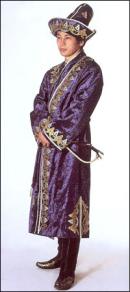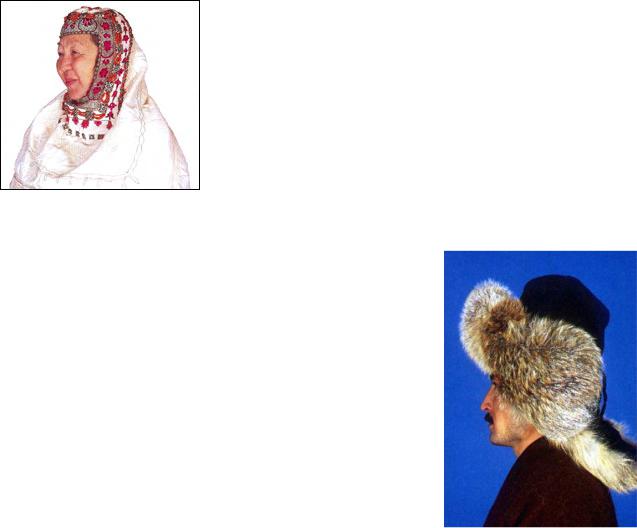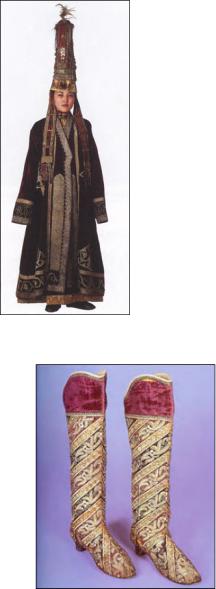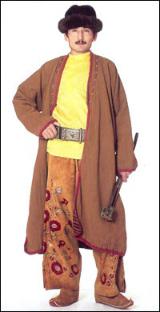
4KTJ5[1]
.pdfMost people have strange feeling about standing before a camera. You have to learn to move and make different designs with your body.
You feel like you’re a clothes hanger. One day someone will say you’re great. In the next studio they will say you’re terrible. It changes from minute to minute: acceptance, rejection.
My feelings are ambivalent. I like my life because it does give me freedom.
I usually don’t tell people that I am a model. I say I’m an actuary or something.
I don’t like to look at my pictures. I don’t like to ride by and see some advertisement and tell everyone that’s me.
Most models, after one or two years, can’t be very interested in it. But they get involved with money, so it’s difficult for them to quit. And there’s always the possibility of the commercial that’s going to make you twenty thousand dollars at one crack. You can work very hard all year on photos and not make as much as you can on two television commercials.
(adapted from “Working” by Studs Terkel, 1988)
Answer the questions:
1.It’s not so easy to be a high-fashion model. What difficulties and surprises do they face?
2.What ridiculous things are there in this profession? Give as much examples as you can.
3.Why don’t you usually tell people that you’re a model?
4.You’ve read an advertisement in a magazine and now you dream of becoming a model. You ring up to the agency and have a talk with an administrator. What did you ask her about? What did she tell you?
5.You’ve being engaged on the job as a model. You’re a beginner. Exchange your opinion towards this with your friend. What do you think about models?
Exercise 1. Olivia wants to be a photo model. She asks for advice. Think about the pros and contras of this profession. You may choose your arguments from the following:
1)If she were a model her face would be familiar in magazine ads and television commercials.
2)If she became a model she would learn to move.
3)If she worked as a model she would be called at 7 in the morning and told to be ready at 8.30.
4)If she were high-fashion model she would earn $ 50 an hour.
5)If she were engaged in this work she would go out with her wardrobe on her arm.
6)If she posed for magazines people would say she is great.
7)If she carried her wardrobe with her she would develop strong muscles.
8)If she were in commercials she would have the possibility of making $ 20000 at the crack.
81
9)If the agency gave her an urgent call (срочно вызывать) she would be fighting to get a taxi.
10)If she got a job on TV she would make on two commercials as much as one does working a year.
Read the interview and say if Denise and Cathy are dressed up to go out or to lounge around (to sit or stand in a lazy way) at home.
Interview: Hi! What kind of clothes do you most like to wear?
Cathy: It depends on my mood. If I’m lounging around at home, it’s always a T- shirt and tracksuit bottoms, but for going out, I like jodhpurs and a smart top.
Denise: For going out wear, I like anything that’s trendy or a bit different, but at home, I like a T-shirt and tracksuit bottoms, too!
Interview: What was the last piece of clothing you bought?
Cathy: I recently bought a black jacket which I wear all the time, and my mum bought me a black patchwork waistcoat as an early birthday treat.
Denise: I’ve just bought a white top and a couple of tiny T-shirts. Interview: What are your favourite shops?
Cathy: I really like Oasis and French Connection, and I usually find things in Top Shop and Kookai as well.
Denise: I get a lot of stuff in Miss Selfridge, Top Shop and even Oxfam. You don’t have to spend a fortune on clothes, but my favourite designer shop is Red or Dead.
1) Join in the conversation and answer the questions in writing.
Linguistic and cultural guide.
Chain store- (also a multiple store) a group of usu. large shops of the same kind owned by one organization.
Deerstalker – a woolen hat with a peak at the front and the back, with ear flaps usually tied together on top. Such a hat was traditionally worn by Sherlock Holmes. Hippie, hippy – (esp. in the 1960s and 1970s) a person who opposes, or is thought to oppose, the accepted standards of ordinary society showing this by dressing in unusual clothes, having long hair (both men and women), living in groups together, and (sometimes) taking drugs for pleasure. Hippies believed in peace.
New Age Traveller – a person who has rejected the values of ordinary society and goes from place to place living in a vehicle. They are disliked and distrusted by many people who believe that they steal things and use drugs.
Punk – a member of a movement among certain young people in the 1970s and 1980s who were opposed to the values of money-based society and who expressed this esp. in loud violent music (punk music), strange clothing, and hair of unusual colours.
Wimpy – a hamburger sold at a Wimpy Bar restaurant.
82
Topical vocabulary
Words and expressions
Bazaar - базар
Chain store - однотипные магазины одной фирмы Clothing - одежда, платье
Costume - одежда, платье, костюм Deerstalker - войлочная шляпа
Earring- серьга
Glengarry- шотландская шляпа
Hairstyle- прическа Hippy- хиппи Jacket- жакет
Jeans -короткие брюки, джинсы
Jewellery- драгоценности, ювелирные изделия Jodhpurs- брюки для верховой езды,
Punk- панки
Ring- кольцо
Sandals- сандалии T-shirt- тенниска
Tam-o’-shanter hat- шотландская шапка (обычно шерстяная, с помпоном на макушке)
Trendy- модный Wardrobe- гардероб Waistcoat- жилет
Home-knitted- домашний, ручной
Stylish- стильный
To dress up- изысканно одеваться, надевать маскарадный костюм To fit- соответствовать, годиться, хорошо сидить
To match- подходить под пару, сочетать To pierce- прокалывать
To shop- делать покупки
To suit- быть к лицу, подходить, соответствовать
To be out of/in fashion- быть в моде
To be the height of fashion- одеватьсяпо последней моде
To be up with fashion- поддерживатьмоду To follow fashion- следоватьмоде
Exercise 1. Translate into Russian/Kazakh using a dictionary.
Nowhere in England is class distinction to be seen more clearly than in the shops. On a large open corner stands a store, the windows of which run for fifty yards down one street and fifty down the other. We enter this department store, and Kitty suggests that we visit the food section. The first thing that strikes us is its comparative emptiness. There are, indeed, two or three people at each counter. But
83

no queues, no people in the centre of the shop. The customers are much more expensively dressed than Kitty.
It is true that this store has all that can be found in every grocery: tea, outmeal, spices, cocoa, bacon, ham, butter, cheese and the rest.
“You needn’t be surprised if I don’t want to buy anything here, ” Kitty puts in. “This is all far above folk like us.” “But you could buy your tea and rice are in special blends and packs, and cost a good deal more than I pay.”
We pass on into other departments. Expensive furs, beautiful evening frocks and cloaks, shoes of every pattern, but all priced high.
Kitty winks at us, and then goes up to a shop assistant.
“Excuse me, can you tell me where I shall find warm woollies for my husband?”
The shop assistant slowly looks Kitty up and down, taking in her shoes slightly down at the heels, her neat but inexpensive tweed winter coat, her little felt hat, and answers, “I’m afraid you’ll find nothing to suit you here.”
G. Bidwell “The British Scene”
Exercise 2. Translate into English.
1. Я покупаю продукты в магазине, который находится на первом этаже нашего дома. 2. Здесь можно купить все продукты, кроме овощей. 3. Обычно я хожу в магазин после работы. 4. Иногда я заказываю продукты по телефону и вечером получало их. А где вы покупаете хлеб? – В булочной. 5. А где вы покупаете мясо, овощи? – В продовольственном магазине, который находится рядом с нашим домом. В этом магазине можно купить мясо, птицу, рыбу, молоко, сыр, масло, консервы. В магазине есть овощной отдел, где можно купить овощи, фрукты.
KAZAKH TRADITIONAL COSTUMES
A modern fashioned bridal attire
The National State Museum of Kazakhstan is a treasure house where one can find many wonderful samples of Kazakh traditional costumes. On display here, are clothes that once belonged to prominent figures of Kazakh history, batyrs, akyns and artists, in particular, the stage-costumes of famous singers like Kulyash Bayseitova, Zhamal Omarova and Rosa Baglanova, and the celebrated dancer Shara Zhicnkulova. Outstanding among the expositions arc: the gold-thread-embroidered beshmet (a coat worn over a dress) owned by Fatima, the wife of Zhangir, the last khan of Bukrey-Orda; and robe lined with swan down that belonged to Tazhibai, the younger sister of the renowned Kazakh scientist and traveler of the 19th century Chokan Valikhanov.
Many varieties of these traditional costumes have withstood the test
84
of time in beauty and style, which explains why they are still worn today despite their ancient fashion.
Kazakh traditional costumes were made from well-chosen materials and fashioned to suit the conditions of nomadic life and the ever-fluctuating weather conditions. It could stand hard frosts and the weary heat, Durable, comfortable, simple and practical best qualifies most of these clothes, Apart from the general men's, women's and children's wear, these costumes fall into different classifications according to the occasion for which it is meant, namely outer garments and underclothes, occasional, seasonal and daily wear.
Daily wear really differed from the occasional in its simple design and fashion. Occasional, in contrast to daily wear, were complexly designed and tailored from valuable plush, velvet, crepe, broadcloth, satin, silk, brocade and other expensive fabrics. To make them more sophisticated, these clothes were artistically embroidered with gold and silver thread, heads, silk, and decorated with pearls, corals, and carnelian insertions. But the pains taken to do them are not in vain, for these clothes are fashioned to accentuate the beauty of these steppe inhabitants, give their natural appearance a special charm and make them more attractive and graceful State Museum of Kazakhstan is a treasure house where one can find many wonderful samples of Kazakh traditional costumes. On display here, are clothes that once belonged to prominent figures of Kazakh history, batyrs, akyns and artists, in particular, the stage-costumes of famous singers like Kulyash Bayseitova, Zhamal Omarova and Rosa Baglanova, and the celebrated dancer Shara Zhicnkulova. Outstanding among the expositions arc: the gold-thread-embroidered beshmet (a coat worn over a dress) owned by Fatima, the wife of Zhangir, the last khan of BukreyOrda; and robe lined with swan down that belonged to Tazhibai, the younger sister of the renowned Kazakh scientist and traveler of the 19th century Chokan Valikhanov.
Many varieties of these traditional costumes have withstood the test of time in beauty and style, which explains why they are still worn today despite their ancient fashion.
Kazakh traditional costumes were made from well-chosen materials and fashioned to suit the conditions of nomadic life and the ever-fluctuating weather conditions. It could stand hard frosts and the weary heat, Durable, comfortable, simple and practical best qualifies most of these clothes, Apart from the general men's, women's and children's wear, these costumes fall into different classifications according to the occasion for which it is meant, namely outer garments and underclothes, occasional, seasonal and daily wear.
Daily wear really differed from the occasional in its simple design and fashion. Occasional, in contrast to daily wear, were complexly designed and tailored from valuable plush, velvet, crepe, broadcloth, satin, silk, brocade and other expensive fabrics. To make them more sophisticated, these clothes were artistically embroidered with gold and silver thread, heads, silk, and decorated with pearls, corals, and carnelian insertions. But the pains taken to do them are not in vain, for these clothes are fashioned to accentuate the beauty of these steppe inhabitants, give their natural appearance a special charm and make them more attractive and graceful
85

OUTERGARMENTS
Young men's occasional costume - headwear aiyr kalpak, overcoat shapan, and decorated high boots taptauryn.
Hide and fur of domestic and wild animals processed by a special ancient recipe were used to make traditional outer garments. The shapan, a warm, long overcoat, is one of the ancient outergarments of Kazakh traditional clothes. Shapans differed by the technique of manufacture and purpose and fashioned either with a turndown or a stand-up collar. From time immemorial, it was considered that what made the shapan very convenient was its wrap-fasten. A richer variety of it is the syrmaly, which is a quilted and sewn m a denser material. The Kaptal is another
model with a warm lining. Another type is the shabu, which is trimmed with fur. The zhargak shapan is meant for occasions and fittingly decorated with ornamental patterns. It is the favourite overcoat of dzhigits (young men). The shekpen is a warm homespun coat made of camel wool. Another property of this coat is that the fur from which this coat is made is water-repellant making it withstand light showers. The most beautiful shekpen, the shide is woven out of a year-old camel's wool. This very soft and delicate wool gives the shekpen its attractive look.
Fur-coats for daily wear and household work were mainly sewn from sheep and goatskin.
Another type of winter outer-garment is the ishik - a fur coat sewn with special craftsmanship out f the fur of the wolf, fox, sable, astrakhan or the like. The kupi is a light warm coat lined with camel or sheep wool. The outer fabric is made from velvet or other coarse, durable, soil-resistant fabrics. It is a popular wear for men, women and children like. Ladies' kupi came with ornamental embroidery on the collar. The sleeve hems were furred with otter. The kupi is an indispensable outer-garment during the mild frosts in spring and autumn.
DRESSES
Among the Kazakh traditional ladies' wear, dresses tor girls and young women called locally koilek, takes a special place in terms of beauty. These ladies look very graceful in their long flimsy dresses, which seem air-filled along the length, the sleeves and around the collar.
The most beautiful dresses are those with delicate silk fringes. The decorations around the collar were made to accentuated the delicate curves of the neck. Kunikey koilek is made of light, fluffy material densely gathered at the waist. The long sleeves are also gathered. Usually, unmarried girls wear it. In them they seem like enigmatic, fairy beauties, literary "sun-like", as the meaning of the Kazakh word 'kunikey'.
86

HEADGEAR
This head shawl, kimskek was purposed for occasions
Wearing of traditional headgear dates back to the 15th century when Kazakh Khanate was formed. And From the kind of headgear a person wore, it was easy to determine from which class of society he belonged. For example, a bai (rich man), mapile (man of nobility) or a biy (.iteppe judge) wore the aiyr kalpak - a high pointed
cap with a divided turn-up. It was sewn from expensive fabric d richly decorated with ornamental patterns. One part of the divided turn-up symbolized wealth, the other - power.
Summer varieties of this cap were made from white felt. The kalpak is elegant, convenient, and protective from the heat in summer and keeps out the cold during the winter.
Another traditional men's headgear is the borik - a rounded warm cap, trimmed with astrakhan otter, marten or raccoon fur. In the harsh winter cold, the men wear the tymak, a fur cap with three flaps - a pair for the ears and a longer and broader flap for the hind head down to the back. One of men's headgear models widespread since the ancient times is kulapara, a type of hood, worn by
hunters, berkutchi (those who train and hunt with the golden eagle), shepherds and herdsmen. The one with a ponited top is worn when raining, while the winter variety has a rounded top like the takiya, and gives good protection from the cold and strong wind. To camouflage the animals, hunters wear a white kulapara in winter, a green one in summer and a yellow in the autumn. The main distinction of the kulapara is that unlike other headgears, it is attached to the collar of the outerwear. The takiya is a light, rounded men's headgear made with a lifted, flat or pointed top. Decorations on this cap are usually in the form of zoomorphic embroidery or floral patterns of complex compositions of 'horn' or 'bindweed' shapes.
Women's headgears are much more complicated in make and more richly decorated. Ladies' takiya. for example, is embroidered with gold and silver thread in addition to the decorative coins, beads, beautiful buttons and precious stones. Girls sport such festive headgear on occasions, but the married women wear it under the kimishek - a type of head shawl, made from very light material, like the one usually worn by Muslim women. The ends around the facial opening are hemmed with beads, pearls or coral.
87

Saukele - bridal headgear
The most beautiful traditional ladies' headgear, saukele, is worn by a bride on her wedding day and during the first year of their marriage. Every pattern on the saukele had its significance. A quick glance at a bride's saukele is enough to tell those who know the significance of all these symbols much about the bride. Saukele like the takiya is richly trimmed with embroidery, precious stones, beads and valuable fur. Ladies' borik much resembles the men's by shape, except that it carries much more decorations. The type trimmed with otter's fur is called Kamshat, the one decorated with gold galloon - altyn, and that decorated with corals - kalmarzhan.
FOOTWEAR
Ladies high-boots - saiyan.
Shoemaking was a well-developed craft with the Kazakh people. All the primary materials needed for making the shoes like rawhide cords and straps, skin, sinew threads as well as the professional devices and various lasts were made by the shoemaker. Ancient Kazakh footwear had one peculiarity. The soles were cut square, which made them fit either foot. Such footwear really took a lot of time to wear out and did not need time to make out which one was meant for which foot.
Summer boots were made from light leather in contrast to the winter foot wear which were from much thicker leather and tailored with exceptional craftsmanship. There are a few types of men's footwear. Riding boots, kaykayma or kayky has often had a pointed turn-up. Such hoots were heelless with very thin soles. Young men used to wear such boots at the weddings. Saptama-boots is ancient winter footwear made from well-curried horse or ox hide, Worn with special felt stockings that usually reached the knee protruding out of the boots. For this reason the bootlegs were made long and wide. Men's working boots called shokay, were made of rough leather with hair. The wide bootlegs were fastened with rawhide belts. These boots like the saptama-boots were worn on felt stocking-boots baypak, which might as well be worn separately wrapped with velvet, skin or other material. Another kind of felt boots is the buiyk, a sort of valenki that were worn over other boots to keep the feet warm during the most severe frosts, snowstorm or night watch.There existed occasional boots of different style too. For example, taptautyn - the exquisite hoc with turned-up toes, incrusted with silver that were mostly made out of horse croup skin. Another kind was the shonkayma - the high-heeled boots, usually worn at
88

festivals by Kazakh sere (wandering poets-musicians).In making these boots, Kazakh shoemakers for the first time began to use different lasts for the t and left foot. Boots for daily wear were made of cattle skin. They were of simple cut, stitched on the outside had a straight sole. That was the footwear preferred by the cat tic-breeders, shepherds and hunters. The boots with soft sole were called zhumsak taban. Those made of rawhide, kok, had no heels and were comfortable for walking on rocky grounds.
The daily wear of young men comprises of the headgear borik, a suede coat, zhargak shapan, decorative belt beldik, suede trousers zhargak shalbar, and high-boots made from suede
The masi are soft thin boots with thin soles. Galoshes - skin (kebis) or rubber (lastyk) - were n over the masi to protect it from dirt, dust and moisture. The galoshes had thick sole and highheels. Besides the ordinary ones, kebis were made with short bootlegs like overshoes.
There also existed a diversity of ladies' and children's footwear, which looked more smart and exquisite, They were as usual specially decorated, The summer models, unlike the men's, were always made with short bootlegs or without ones
altogether making them resemble sandals. Women's masi, for example were made of chagrin leather or some other delicate skin with the bootlegs trimmed with fur or leather of another colour. Ornamental patterns usually served as decorations on them. Kebis to be worn over ladies' masi were always made high-heeled with pointed curved toes.
Kazakh traditional costumes are a treasury of folk art that fades into antiquity and is strongly linked with nomadic traditions. From them, one can easily decipher all the familiar shades of colours closely linked with the steppes. It is a treasury that has not yet revealed all its secrets and has much store to make wonder even the modern masters of fashion in search of new ideas
89
UNIT 6
The Theme: HEALTH AND SPORT.
Grammar: PAST SIMPLE AND PAST CONTINUOUS.
Texts: SPORT IN OUR LIFE, MY FAVOURITE SPORT, AT THE DOCTOR’S.
Exercises.
Past Simple and Past Continuous
1 Past Simple irregular verbs
Complete the table with Past Simple irregular verbs.
infinitive |
past |
infinitive |
past |
bite |
bit |
ring |
|
break |
|
shut |
|
build |
|
spend |
|
catch |
|
steal |
|
draw |
|
swim |
|
fight |
|
teach |
|
hear |
|
throw |
|
leave |
|
wear |
|
lend |
|
win |
|
meet |
|
write |
|
2 Past Simple
Write Past Simple sentences. (√) = affirmative, (?) = question, (X) = negative. Then circle the sentences which are repeated actions.
1 (that boy/break) my window (?)
Did that boy break my window?____________
2 I (drive) to work every day last year. (√)
______________________________________
3 (Laura/just hit) that boy (?)
______________________________________
4 James (keep) the book about films. (X)
______________________________________
5 We (meet) them last night. (X)
______________________________________
6 why/you/put) that there (?)
______________________________________
7 We always (sit) at the same desks (√)
______________________________________
8 An American (win) Wimbledon last year (√)
_____________________________________
90
